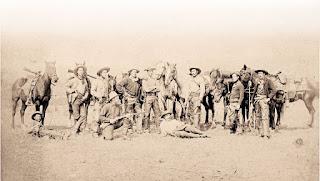Rocky Mountain Rangers of 1885
Today the Rocky
Mountain Rangers are a reserve infantry regiment of the Canadian Army
headquartered in Kamloops , BC Rocky Mountains .
North of the Cypress Hills in that part of the Northwest Territories Saskatchewan Hudson Canada
Those people with
treaties where also not fairing very well. Dishonest Indian agents issued short
rations or damaged goods and sometimes both. Primarily this was due to racism
or ignorance on the part of government officials but it was also aggravated by
the fact that the Federal Government didn’t have any money in their coffers.
There are several instances recorded both officially and unofficially of the
North West Mounted Police securing provisions for a starving community. It
wasn’t their job but they where on the ground seeing the devastation.
Whatever the reason, in
1885 the Métis, led by Louis Riel (political leader) and Gabriel Dumont
(military leader) demanded better. High handed and insulting responses from
government agents (including NWMP officers) resulted in violence. In a very
short time the Métis were joined by some Cree and Assiniboine . It has been called the Second Riel Rebellion, the Métis War
and other names but in recent years it appears we have settled on the Northwest
Rebellion.
There have been
countless essays and books written on the subject with views from both sides
and including far more details than will be found here. No one has reached a
definitive understanding but it is apparent that several people died and both
sides were wrong.
With many peoples
represented in the rebel forces the white settlers, farmers and ranchers were
afraid that the violence would spread. For most of the five month duration of
hostilities it was feared the members of the Blackfoot Confederacy would join
although that never happened due primarily to their treatment by the NWMP and
the agents who served their locations. To heighten everyone’s fears a
contingent of Mounted Police were sent to assist the Canadian soldiers in
quelling the uprising thus reducing an already undermanned force.
To
counter this threat the Rocky Mountain Rangers were formed, a militia made up
of volunteers. They were primarily ranchers and cowboys with some of them being
retired Mounted Policemen. The General Order creating them called for them to
“guard the two hundred mile frontier between Lethbridge
Rocky Mountain Ranger Major John Stewart
with what appears to be a Smith & Wesson Model #3
Rocky Mountain Ranger Jack Clark
w 1873 Winchester
RM Ranger Henry Boyle, brother of
Richard (Lord) Boyle who Captained one of the troops.
Divided into three troops the
Rangers patrolled their designated area. They had three major confrontations,
border crossing Indians rustling horses near the Cypress Hills, outlaws near Medicine Hat High River
R M Ranger patrol near Medicine Hat
R M Ranger patrol in the Cypress Hills
After three months service the
Northwest Rebellion had been quelled and those NWM Policemen on war service had
been returned to their original duties. The Rocky Mountain Rangers were ordered
back to Fort
Macleod July
17, 1885 . Major
Stewart arranged for them to receive the North West Canada Medal and they were
eligible for 320 acres of homestead or eighty dollars.








Comments
Post a Comment